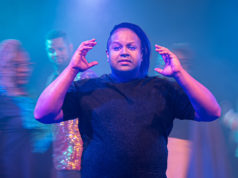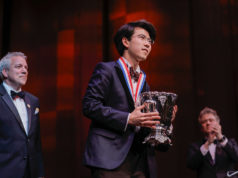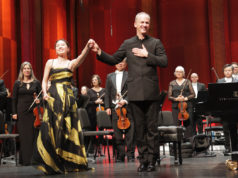Amorous relations inspired identity crises on two local stages last week. At Amphibian Stage Productions, local playwright Kathleen Culebro debuted her new play, Smart Pretty Funny, a story of characters falling apart to come together. Coming together to fall apart, the romance in The Phantom of the Opera haunted our hearts long enough to lose sight of the realistic implications of loving a serial-killing ghost.
In Culebro’s script, an anonymous and omnipotent entity sends every person on earth a letter with the name of the recipient’s soulmate — everyone except Meg (Vanessa DeSilvio), a quantum physicist whose partner leaves her for a new lover in Portugal. Lonely and inconsolable, Meg laments her lost love while the other characters rush in with advice. Her sister Sophia (Anastasia Muñoz) and brother-in-law David (Ivan Jasso) give unsolicited guidance, despite struggling through their debacle as a married couple whose letters didn’t match. Meg’s mother Alicia (Gretchen Corbett) offers companionship so that she might sidestep her own match as long as possible. Meanwhile, waiting calmly for the family’s love crises to pass is family friend Teddy (Van Quattro), who anchors the other characters in reality — until a character disrupts the destiny penned for him.
[box_info]Smart Pretty Funny
Thru November 13 at Amphibian Stage Productions, 120 S Main St, FW. $33. 817-923-3012.[/box_info]
Teddy possessed impressive consistency of character, cupping every line with great honesty, which is to be expected of an actor with so many titles and credits to his name. Slightly more frenetic was the character of Sophia, a role well managed with appreciable ease and great entertainment value, and Alicia’s well-measured apprehension was affable, the kind of awkward charm more sitcom characters should master.
To Scenic Designer Bob Lavallee’s credit, the box set design of the living/ dining room was as smart as it was pretty. Modular white furniture glided across stage to change the dynamics of the space in connection to the exchanges that occurred between characters. Cerulean blue flats were dotted with white bird decals to give a sense of levity across the stage, anchored by a television screen that appeared and disappeared in upstage center. Letters never littered the stage, as one might expect, but a spectacle of letters floated in the lobby. A charm of the Phibs’ is always this front of house space, which is often dripping with creative storytelling props before the first word is ever spoken.
What purports to be a romantic comedy sketch is more farcical than frivolously lighthearted, full of buried surprises and comedic highlights that have become a signature artistic element embraced by Culebro. Her ability to develop character relationships with astounding depth and at a swift pace forces viewers to process her fresh content more esoterically.
Under the direction of Cameron Mackintosh, Andrew Lloyd Webber’s time-honored tale of the Phantom is almost dizzying, dancing in concentric circles around past productions. With due credit to a strong cast, this production revolves around an eye-catching set design flaunting impressive new innovations that don’t detract from the grandiose aesthetic of a 1911 Parisian opera house.
When ballerina Christine Daaé (Katie Travis) is coaxed into covering for a struggling soprano, she’s launched into a new career as an operatic star, but the angel of music she credits for her voice soon reveals himself to be a monstrous spook with a knack for vocal performance. For a few days, the Phantom (Derrick Davis) tempts her with seductive ideas in his labyrinth underground. Upon returning to her stage life, our ingénue enlists the help of her lover, Raoul (Jordan Craig), to protect her from the Phantom. The all-mighty masked man overhears them and then plots to circumvent their plans and frighten the entire company with a few murders. Before Christine must decide between two drastically different men with far too much control over her fate, the French must have a fabulous masquerade, arguments over the state of the arts, and a dramatic opera premiere for our antagonist to crash.
Both in terms of physical stature and acting ability, the Phantom was a towering force on stage. The bipolarity of this performance was on par with the sentimentally sinister signature nature of this character and a welcome contrast to sweet high E notes sung by Christine. Prima Donna Carlotta’s aria-like solos showboated well, as one would hope, and the rest of the cast complemented her exceptional vocal range with a number of other accomplished sopranos and tenors. The drawback of directing several profoundly powerful stage presences is that the audience can see every pin fallen out of place. More than obvious in this production was that the ballet line struggled with the consistency of port de bras in the earlier scenes. The ensemble improved by Act II, donning better pointe technique.
Set designer Paul Brown made his stage feel menacingly close to the audience. A crystal chandelier plummeted from the ceiling, stopping close to the audience before any real danger occurred. Masking hid parts of the set in certain scenes, adding to the immersive fantasy feel of this musical along with lighted flies and soaring props — so large that another stage brace was needed to prevent swaying. At the epicenter of the design spun a two-story revolving platform outfitted with one red interior room and a posterior wall of mechanical steps floating out and into the wall, long enough to form a floating staircase before retreating under the actors’ steps. Between the labored woes of love’s dubiety, the set put on its own dramatic show.












